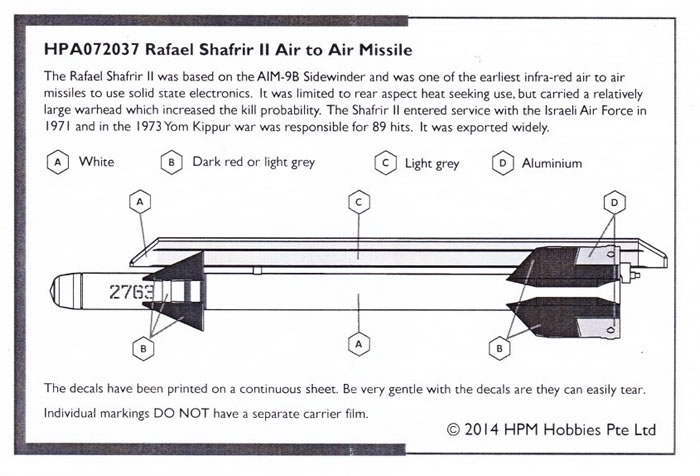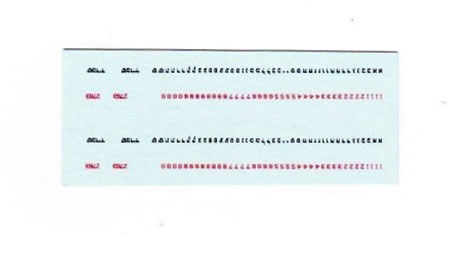|
Rafael Shafrir II
Missiles & Rails
.jpg)
High Planes Models, 1/72 scale
S u m m a r y : |
Catalogue Number: |
HPA072037 - Rafael Shafrir II Missiles & Rails |
Scale: |
1/72 |
Contents & Media |
Two resin missiles rendered by 3-D printer. |
Price: |
Available on-line from HPM Hobbies for USD$7.93
Click here for currency conversion. |
Review Type: |
First Look. |
Advantages: |
Really nice scale finesse and no assembly required. |
Disadvantages: |
No decal placement guide. |
Conclusions: |
Like the Highplanes’ Matra Magics I reviewed some time ago, these are some of the best after-market missiles of any kind I have encountered. This is due to their finesse and completeness, with no assembly required, and made all the better by the inclusion of a painting guide. The lack of guidance for decal placement is a minor mater as the markings are so small as to almost be unnoticeable. I highly recommend this missile set. |
Reviewed
by Mark Davies

cyber-hobby's 1/72 scale Sea Venom is available online from Squadron.com
The Rafael Shafrir II belongs to a family of air-to-air missiles (AAMs) built by the Israeli weapons manufacturer Rafael Advanced Defense Systems, formerly RAFAEL Armament Development Authority.
Originally starting with the Shafrir series, the Shafrir II missile was developed in 1959, followed by the Shafrir II in early 1970s. Subsequently, the missiles were given the western name of "Python" by the parent company for export purposes, starting with the Python III in 1978.
In the 1950s, the Israeli Air Force (IAF) submitted requirements for a domestically-made air-to-air missile, to promote domestic defense industry and reduce reliance on imports. Rafael Armament Development Authority was contracted to develop the Shafrir in 1959. The missile entered operational status with Israeli Mirage jets in 1963, but the IAF was unhappy with its performance and no air combat kills were achieved with it during the Six-Day War, kills being made with guns instead. The improved Shafrir II was soon introduced in 1971, it proved to be one of the most successful and deadly missiles ever made. During the 1973 Yom Kippur War, the IAF launched 176 Shafrir II missiles, destroying 89 enemy aircraft. The Shafrir II was exported along with Israeli-made aircraft to South American countries.
The Shafrir II is credited with a total of 106 kills during its whole service life.
Source: Wikipedia
Previous 1/72 Scale Rafael Shafrir II Missiles
The Shafrir II is based on the AIM-9B Sidewinder, and looks very similar indeed to me; so quite possibly 1/72 scale Sidewinders have substituted successfully enough in the past for the Israeli copy. However, I am unaware of the Shafrir II being offered 1/72-scale previously, so High Planes’ release should be welcomed by fans of Israeli fighter subjects of the 1970’s and 80’s, if indeed there are external differences between the two types. (As an aside, the Shafrir II has been released by at least a couple of brands in 1/48 scale.)
The two missiles and their launch-rails come in clear plastic blister pack, along with a painting guide and decal sheet. The parts are further enclosed in a zip-lock plastic bag.
.jpg)
Each missile is made as one piece and has very delicate fins; every bit as fine as PE parts would be, but without the hassle of having to fit 12 fiddly little fins spaced and aligned precisely on a resin missile body. Pleasingly, a painting guide is provided, something lacking in High Planes’ Matra R.550 Magic missile release that I reviewed in March 2014.

The decal sheet is potentially another plus, with a selection of tiny black and red Hebrew script. However, whilst the painting guide mentions that the decals share a common carrier film, it gives no obvious advice on their placement. The guide does feature a four digit code in Arabic numerals (2763) on the missile’s nose, but these numerals are not included on the decal sheet. No doubt an internet search may provide suitable guidance for decal placement.

The missiles and their launch-rails are made using a 3-D printer. This explains how such delicate fins can be produced without risk of damage, as would be the case with resin when being removed from a silicon rubber mould.
.jpg)
The printing process has enabled the nose to be made fairly clear, which is handy for portraying the missile’s seeker-head.
Like the High Planes’ Matra Magics I reviewed some time ago, these are some of the best after-market missiles of any kind I have encountered. This is due to their finesse and completeness, with no assembly required, made all the better by the inclusion of a painting guide.
The lack of guidance for decal placement is a minor mater as the markings are so small as to almost be unnoticeable.
I highly recommend this missile set.
Thanks to HPM Hobbies for the review sampl
Text Copyright © 2015 by Mark Davies
This Page Created on 29 January, 2015
Last updated
29 January, 2015
Back to HyperScale
Main Page
Back to Reviews
Page
 |
